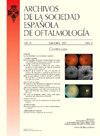Experiencia de la aplicación de toxina botulínica tipo A como tratamiento de los trastornos hipercinéticos faciales en un centro oftalmológico de referencia mexicano
Q3 Medicine
Archivos De La Sociedad Espanola De Oftalmologia
Pub Date : 2025-04-01
DOI:10.1016/j.oftal.2024.12.003
引用次数: 0
Abstract
Background and objective
Blepharospasm is characterized by involuntary, sustained spasms of the orbicularis oculi, corrugator, and procerus muscles. Hemifacial spasm (HFS) is characterized by the involuntary tonic-clonic contraction of the muscles of a hemiface. The main role of botulinum toxin type A (BoNT-A) in the treatment of blepharospasm and HFS is recognized by guidelines around the world. In this study, we evaluated the applicability of botulinum toxin type A in patients with periocular hyperkinetic disorders at the Instituto de Oftalmología Fundación Conde de Valenciana, so that we can share the Mexican experience with the international evidence.
Materials and methods
The clinical records of patients diagnosed with facial hyperkinetic disorders treated with botulinum toxin type A (BoNT-A) that were treated from January 2015 to September 2021 were analyzed.
Results
A total of 140 records of patients diagnosed with facial hyperkinetic disorder and treated with BoNT-A were analyzed. Facial hyperkinetic disorders that occurred included 5 (3.6%) patients with orbicularis oculi myokymia, 72 (51.4%) with blepharospasm, 62 (44.3%) with hemifacial spasm, and 1 (0.7%) with Meige syndrome. One hundred and twenty patients (85.7%) reported remission of initial symptoms after BoNT-A therapy during the period covered by this study.
Conclusions
Botulinum toxin type A is effective and safe as a treatment for facial hyperkinetic disorders in the Mexican population.
在墨西哥一家参考眼科中心使用A型肉毒杆菌毒素治疗面部多动障碍的经验
背景与目的眼睑痉挛的特征是眼轮匝肌、瓦楞纸肌和降肌的不自主、持续痉挛。面肌痉挛(HFS)的特点是半面部肌肉的不自主强直阵挛性收缩。A型肉毒毒素(BoNT-A)在眼睑痉挛和HFS治疗中的主要作用已被世界各地的指南所认可。在本研究中,我们在Oftalmología Fundación Conde de Valenciana研究所评估A型肉毒杆菌毒素在眼周运动障碍患者中的适用性,以便与国际证据分享墨西哥的经验。材料与方法分析2015年1月至2021年9月以A型肉毒毒素(BoNT-A)治疗的面部多动障碍患者的临床记录。结果对140例面部多动障碍患者进行BoNT-A治疗。发生的面部多动障碍包括眼轮轴肌肌肌无力5例(3.6%),眼睑痉挛72例(51.4%),面肌痉挛62例(44.3%),梅格综合征1例(0.7%)。120例患者(85.7%)报告在本研究期间BoNT-A治疗后初始症状缓解。结论A型肉毒毒素治疗墨西哥人群面部多动障碍是一种安全有效的治疗方法。
本文章由计算机程序翻译,如有差异,请以英文原文为准。
求助全文
约1分钟内获得全文
求助全文
来源期刊

Archivos De La Sociedad Espanola De Oftalmologia
Medicine-Ophthalmology
CiteScore
1.20
自引率
0.00%
发文量
109
审稿时长
78 days
期刊介绍:
La revista Archivos de la Sociedad Española de Oftalmología, editada mensualmente por la propia Sociedad, tiene como objetivo publicar trabajos de investigación básica y clínica como artículos originales; casos clínicos, innovaciones técnicas y correlaciones clinicopatológicas en forma de comunicaciones cortas; editoriales; revisiones; cartas al editor; comentarios de libros; información de eventos; noticias personales y anuncios comerciales, así como trabajos de temas históricos y motivos inconográficos relacionados con la Oftalmología. El título abreviado es Arch Soc Esp Oftalmol, y debe ser utilizado en bibliografías, notas a pie de página y referencias bibliográficas.
 求助内容:
求助内容: 应助结果提醒方式:
应助结果提醒方式:


